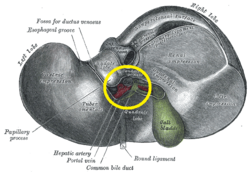Biology:Hilum (anatomy)
From HandWiki

Hilum of the liver.
In human anatomy, the hilum (/ˈhaɪləm/; pl.: hila), sometimes formerly called a hilus (/ˈhaɪləs/; pl.: hili), is a depression or fissure where structures such as blood vessels and nerves enter an organ. Examples include:
- Hilum of kidney, admits the renal artery, vein, ureter, and nerves
- Splenic hilum, on the surface of the spleen, admits the splenic artery, vein, lymph vessels, and nerves
- Hilum of lung, a triangular depression where the structures which form the root of the lung enter and leave the viscus
- Hilum of lymph node, the portion of a lymph node where the efferent vessels exit
- Hilus of dentate gyrus, part of hippocampus that contains the mossy cells.
 |

